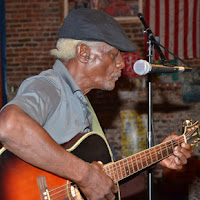Jimmy ‘"Duck" Holmes is the only known surviving practitioner of an endangered blues tradition, the "Bentonia blues", a style born in and around the small Mississippi town of Bentonia (read below). It is said that this unique style of blues was "invented" by Henry Stuckey (1897-1966) who learned an open E minor guitar tuning from black Bahamian soldiers while serving in France during World War I. Returning home, he incorporated and extended this type of tuning to his playing, eventually showing it to Skip James (1902-1969) and Jack Owens (1904-1997).
Holmes never met Skip James who left Bentonia when he was a child, but learned from Jack Owens, who ran a weekend juke-joint in town for most of his life. He became a frequent visitor to the Blue Front Cafe (read below), another juke-joint operated by Holmes's parents, and set himself to transmit the Bentonia blues style to Holmes who learned by watching and listening Owens play, both being unable to read or write music.
 Different from the nearby Hill Country blues style, though there are some similarities, the Bentonia blues distinctive "secret" is its use of Open E minor and Open D minor tuning which gives the music a unique mournful, listless tonality, largely confined to the past until Holmes started to record again. Again because the famous and inexhaustible Library of Congress ethno-musicologist Alan Lomax had already recorded a few samples of his songs in the 1970s.
Different from the nearby Hill Country blues style, though there are some similarities, the Bentonia blues distinctive "secret" is its use of Open E minor and Open D minor tuning which gives the music a unique mournful, listless tonality, largely confined to the past until Holmes started to record again. Again because the famous and inexhaustible Library of Congress ethno-musicologist Alan Lomax had already recorded a few samples of his songs in the 1970s."Gonna Get Old Someday", released in 2008 but recorded in 2003, is in fact Holmes' first album chronologically. Holmes offers twelve tracks of plain, relatively repetitive and monotone country blues that is at the same time ethereal, gritty and rough, even crude, but amazingly beautiful in its simplicity and raw expressiveness. This hypnotic album is a form of bare musical catharsis impossible to resist. It takes the listener back to the origins of blues, to its very essence.
Thanks to the Duck, now 74, the Bentonia blues style is surviving. Let's hope that like Holmes did from Owens, some young bluesmen will take on the torch from him before it's too late. In the meantime the Bentonia style would deserve to receive the Unesco's Intangible Cultural Heritage label.
Located on the South-East edge of the Delta, about 20 miles north of Jackson, Bentonia is a small half deserted town of not more than 400 residents today. It takes the form of a crossroad occupied by a few scattered business services, farm-houses and ancient warehouses and cotton gins. Its location on the Illinois Central Railway used to draw numerous visitors, but today, if the train still runs through town daily, it doesn't stop anymore, and a nearby four-lane highway diverts traffic away from Bentonia. Most of the businesses of Holmes' youth have shuttered, buildings have been torn down, and more than a quarter of the residents live under the poverty line. But for blues lovers, there's a mythical place in town.
On a dead end dusty road along the railroad tracks stands a kind of shotgun house with a blue painted front side : the judiciously named Blue Front Cafe, the first Afro-American-owned business in Bentonia when Holmes' parents, who were sharecroppers, opened it in 1948, a year after he was born. It was then a gathering spot much appreciated by field hands from the surrounding cotton plantations where they could eat and drink a home-made bootleg Moonshine while tasting some good ol' Bentonia blues.
































